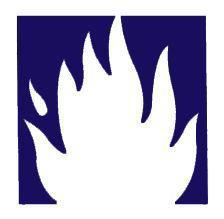SAS Urban Survival Handbook (56 page)
Read SAS Urban Survival Handbook Online
Authors: John Wiseman
Tags: #Health & Fitness, #Reference, #Survival, #Fiction, #Safety, #Self-Help, #Personal & Practical Guides, #General, #Survival Skills

REMEMBER
Laminated or wired glass may prove difficult to break through (see SAFETY FIRST: Glass). Double or treble glazing that is not designed to open fully may be hard to break. Position a hammer or special breaking tool by windows which must be used as escape routes so that they CAN be used as escape routes if fire breaks out.
Go upstairs
Escaping from upstairs bedrooms will probably have to be done at night. It will be dark. How easy are the routes? Keep all passages and hallways CLEAR and consider fitting handrails to guide and support young and elderly people—particularly where there is a steep flight of steps. If it becomes impossible to escape through the ground floor, look at all possible upstairs escape routes. Do any windows open onto flat roofs, for example? If it is not safe to jump, consider installing some kind of fire escape (see
Fire ladders
).
DRAW UP A FIRE DRILL
Plan and rehearse a family fire drill. This should:
- ■
Indicate where alarm devices are - ■
Establish a special alarm signal that is unmistakable - ■
Indicate where fire extinguishers are - ■
Indicate where escape routes are - ■
Nominate special responsibilities, like: an older child to accompany a younger one, a helper for a disabled or elderly person, someone who will phone for help (from a call box or a neighbour’s home) - ■
Show where to switch off electricity and gas supplies - ■
Give name and address of neighbours who should be alerted – in a multi-occupied building this fire drill should be drawn up with and practised by all of the residents - ■
Give location of an assembly point outside - ■
Give telephone numbers of emergency services
REMEMBER
Practise! Take your family through the fire drill regularly. DON’T just read it, DO IT. In particular, practise difficult escape routes. If these are hazardous, do this as safely as possible – some may be too risky to try except in an emergency. Someone should make sure escape routes are possible, though! If someone comes to stay, remember that they will not know these procedures. Young children could draw or paint their own copies of the fire drill – it will help them to memorize the instructions in it. If you’re staying in a hotel, make sure to read the fire safety information and do a practise walk to the fire exit to familiarize yourself.
Night patrol
Devise a list of things that should be checked before you go to bed at night and get into the habit of going on patrol. Nightly checks should include the following:
- ◑ Make sure you know who is in the house and where they are.
- ◑ Switch off and unplug all electrical appliances in every room, especially televisions.
- ◑ Check that cooker rings and burners are off.
- ◑ Check that fireguards are in place.
- ◑ Turn off gas fires (except pilot lights)—especially portable cylinder gas fires.
- ◑ Unplug electric under/overblankets.
- ◑ Recheck that paraffin stove wicks are completely out.
- ◑ Check that exterior lights are off.
- ◑ Make sure no cigarette ends are left burning.
- ◑ Switch off lights and close doors.
- ◑ Anything else specific to YOUR home.

WARNING
Smoking kills: Cigarettes cause an enormous number of domestic fires every year. If you are a smoker or you live with one, follow this special drill:
- ■
DON’T balance cigarettes precariously - ■
STUB OUT cigarettes properly and make sure matches are out before discarding - ■
PROVIDE deep ashtrays for smokers - ■
DON’T smoke if you are tired or drunk - ■
DON’T smoke in bed - ■
CHECK furniture – feel down the sides of cushions - ■
DON’T discard lighted cigarettes in wastepaper bins
REMEMBER
- ■
Remove old newspapers and flammable objects stored under stairs – DON’T build bonfires anywhere in your home - ■
DON’T overload power points - ■
DON’T let curtains hang down round the back of television sets - ■
Get your household wiring checked by an electrician and check all plugs and appliance wiring - ■
Replace foam-filled furniture and mattresses if you can or treat them with a fire-retardant spray - ■
DON’T use a time switch on unsuitable appliances like electric fires - ■
Keep aerosols and flammable substances away from sources of heat and out of direct sunlight – they can explode - ■
Keep matches and lighters away from children - ■
Don’t leave mirrors and bottles in direct sunlight – reflected and concentrated sunlight can start fires - ■
Don’t use open fires in children’s play areas – use a fireguard and do not leave them unattended - ■
Don’t plug appliances into light fittings - ■
Never overfill pans with fat for frying - ■
Keep clutter out of halls, off staircases and keep escape routes CLEAR - ■
Do not place candles/hot drinks/vases or anything else on top of the television – you could start a fire - ■
Always use correctly-rated fuses in appliances - ■
In the event of a power cut, switch off electrical heaters. It’s easy to forget about them and you may go to bed before the power returns
FIRE!
 Unfortunately there is no way the threat of fire can be ruled out completely. In the urban environment the human error factor – perhaps a discarded cigarette or a faulty piece of wiring – will always limit the extent to which you can protect yourself. Having taken all the precautions, without totally transforming all buildings, the next step is to learn what to do if you find yourself in a fire.
Unfortunately there is no way the threat of fire can be ruled out completely. In the urban environment the human error factor – perhaps a discarded cigarette or a faulty piece of wiring – will always limit the extent to which you can protect yourself. Having taken all the precautions, without totally transforming all buildings, the next step is to learn what to do if you find yourself in a fire.
PLEASE NOTE
The safest course of action in any fire situation is to follow the rules for containing it (by closing doors and windows), to evacuate the building and call the fire brigade. This applies to all types of fire which have taken hold at the flame stage—in certain cases you may have to try to put out a small or developing fire.
- ■
At home
Put your fire drill into action - ■
At work
Follow the fire drill - ■
In a public place
Seek assistance from responsible members of staff etc and make your way to fire exits as quickly and calmly as possible. Help anyone in difficulty.
At home
Initially, a fire in your home may seem containable or controllable. You may think—perhaps because you want to preserve your belongings or to save troubling the fire brigade—that you can cope with a burning sofa or a flaming television, but you are NOT a trained fire-fighter. You are severely at risk from highly toxic fumes in either of these cases. It would be almost impossible to remain detached or calm. If you tried to put out a fire in that state of mind you could help to spread it. Every decision you take COULD make the difference between life and death.
You might walk into a room, discover a fire and run out—in your shock forgetting to close the door behind you. Your attention would be completely taken by the fire—not the fire-feeding draught of air you have inadvertently created by leaving the door open!
Seconds count!
Time is the vital factor in a fire—containing it could give precious minutes to ensure all the occupants of a building reach safety (let the professionals do the rest). Rather than
fighting fire
, the two watchwords are SLOWING and CONTAINING fire. There are often some simple and fast things you can do to slow the progress of a fire. Equally there are ‘safe’ ways of containing a fire in a room or a section of a building.

EMERGENCY!
DOMESTIC FIRES
Try to deal with domestic fires BEFORE they get out of control. Read and commit this information to memory BEFORE the need arises. In all cases, ACT QUICKLY but stay as calm as possible.
CLOTHING FIRE
Most materials burn easily – ’synthetics’ can even melt onto the skin
▶
YOU ARE ON FIRE
Cross your arms over your chest. Put your hands on your shoulders. This should help to protect your face from the flames
DO NOT RUN
This will fan and spread the flames, which will impede breathing
LIE DOWN AND ROLL
Roll over slowly to smother the flames
WRAP YOURSELF UP
In a carpet, wool blanket, fire blanket or non-synthetic curtains
▶
SOMEONE ELSE ON FIRE
Restrain them if they are panicking
LOWER THEM TO THE FLOOR
Trip them up if necessary!
SMOTHER THE FIRE
Roll them in a carpet, wool blanket, fire blanket as above
Cool the temperature of the burns soon as possible with water
Don’t try to remove any clothing which has become stuck to the skin
CALL AN AMBULANCE!
ELECTRICAL FIRE
SWITCH OFF THE POWER
Try to unplug an appliance OR turn off all the power at the consumer unit/fuse box
AT NIGHT
Only switch off at the mains if you have a flashlight so that you can find your way about
SMOTHER THE FIRE
Use a fire blanket or a dry extinguisher—dry powder (blue), CO
2
(carbon dioxide/ black) or halon (green)
TV/VDU FIRE
▶
SWITCH OFF AT THE MAINS SOCKET
OR
▶
SWITCH OFF AT FUSE BOX/CONSUMER UNIT
DO NOT STAND IN FRONT OF THE SCREEN—THE TUBE MAY EXPLODE
USE A DRY EXTINGUISHER AIMED INTO THE TV/VDU
OR
COVER THE TV/VDU WITH A FIRE BLANKET
OR